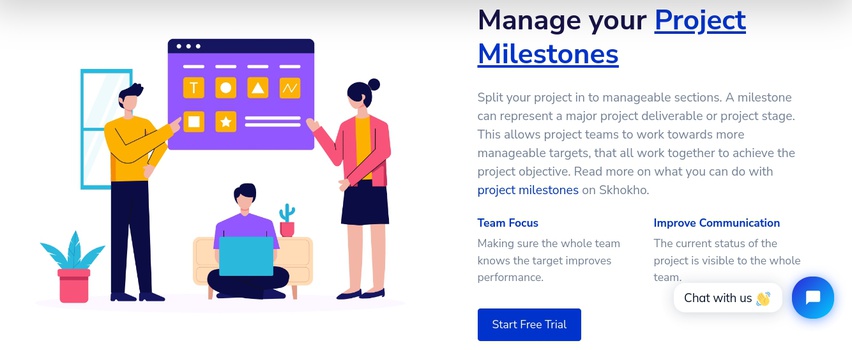Choosing the Right Project Management Tool: A Guide for Small Businesses
Effective project management is crucial for the success of small businesses. Choosing the right project management tool can significantly improve productivity, collaboration, and overall project outcomes. Project management tools are essential for small businesses seeking to streamline their operations and enhance productivity. These tools enable efficient planning, organization, and tracking of tasks, timelines, and resources, providing a structured approach to project execution.

In addition with the increasing complexity of modern business projects, the need for effective collaboration, communication, and task management has never been greater. Project management tools empower small businesses to maintain a competitive edge by minimizing project-related inefficiencies and bottlenecks.
They offer a platform for better decision-making and strategic planning, enhancing the organization's capacity to adapt to changing market dynamics and customer demands. In this blog, we will provide a comprehensive guide to help small businesses in selecting the most suitable project management tool for their specific needs.
This guide will discuss the following:
- Understanding Your Business Needs
- Evaluating Key Features
- Scalability and Integration
- Usability and Learning Curve
- Security and Data Privacy
- Cost and Return on Investment (ROI)
Understanding Your Business Needs
Before embarking on the selection process, it's essential to conduct a thorough analysis of your business's unique requirements. This involves identifying the specific challenges and pain points your team encounters during project execution.
By understanding the current workflow, communication gaps, and areas of inefficiency, you can pinpoint the features and functionalities necessary in a project management tool to address these issues effectively. Consider factors such as the size of your team, the nature of your projects, and the level of collaboration required.

Delving into the scalability and growth trajectory of your business is vital. Consider the potential expansion of your team and the need for collaborative tools that can accommodate future growth. Understanding your business needs not only streamlines the selection process but also ensures that the chosen project management tool aligns seamlessly with your operational objectives, fostering enhanced productivity and project success.
Evaluating Key Features
When evaluating project management tools for small businesses, assessing key features is essential to make an informed decision. Look for robust task management capabilities that allow for easy assignment, tracking, and prioritization of tasks. Integration with calendars and notifications ensures streamlined communication and deadline adherence.
The ability to generate comprehensive reports and analytics empowers small businesses to gain valuable insights into project progress and team performance, facilitating informed decision-making and strategic planning. Evaluating these key features ensures that the selected project management tool aligns with the specific needs and workflows of the small business, enhancing operational efficiency and productivity.

Scalability and Integration
Scalability refers to the tool's ability to adapt and expand alongside the evolving needs of a growing business. It's essential for small businesses to select a project management tool that not only meets their current requirements but also has the capacity to accommodate increased project complexity, team expansion, and diverse workflows as the company grows. This scalability ensures that the chosen tool remains a valuable asset instead of becoming a limiting factor as the business progresses.
Integration, on the other hand, emphasizes the seamless connectivity of the project management tool with other essential business systems and applications. For small businesses, the ability of a project management tool to integrate with existing software, such as customer relationship management (CRM), accounting, or communication platforms, is indispensable. A well-integrated tool fosters enhanced collaboration, efficient data sharing, and a cohesive operational environment. It streamlines processes and minimizes the need for manual data transfers, ultimately saving time and improving the overall productivity of the business. When evaluating project management tools, small businesses should prioritize solutions that offer robust integration capabilities to optimize their workflow and productivity.
Skhokho: A Comprehensive Project Management Solution
Skhokho is a leading project management tool designed to cater to the needs of small businesses. With its intuitive interface, robust feature set, and seamless integrations, Skhokho offers a comprehensive solution for project planning, task management, and team collaboration. It provides small businesses with the agility and flexibility required to thrive in dynamic business landscapes.

Usability and Learning Curve
A user-friendly interface and intuitive design are essential, as they enable team members to quickly adapt to the new tool and seamlessly integrate it into their workflow. By prioritizing usability, businesses can facilitate smooth onboarding processes and minimize the time and resources required for training sessions. A low learning curve ensures that employees can efficiently harness the full potential of the tool without facing unnecessary obstacles, allowing them to focus on driving productivity and achieving project milestones.
Ease of use also plays a key role in fostering user adoption and engagement, as employees are more likely to embrace a project management tool that aligns with their familiarity and doesn't hinder their efficiency. With a tool that offers a gentle learning curve, businesses can foster a culture of collaboration and productivity, empowering teams to collaborate, innovate, and deliver outstanding results while staying agile in a competitive market landscape.
Security and Data Privacy
With an increasing focus on safeguarding sensitive information, it's crucial to choose a tool that prioritizes robust security measures and stringent data privacy protocols. Look for features such as secure data encryption, multi-factor authentication, and role-based access control to ensure that confidential project-related data remains protected from unauthorized access. Consider whether the tool is compliant with industry-standard regulations, such as GDPR or HIPAA, to provide assurance that your business data is handled in accordance with legal requirements.
The ability to control and manage user permissions is integral to maintaining data privacy within the project management tool. A suitable tool should offer granular control over access rights, enabling small businesses to restrict data access to authorized personnel only. By selecting a tool with strong security and data privacy features, small businesses can operate with confidence, knowing that their project-related information remains secure and compliant with relevant privacy regulations.
Cost and Return on Investment (ROI)
While evaluating the cost, it's important to factor in both the initial investment and the long-term expenses, including subscription fees, customization costs, and potential additional features. Understanding the tool's potential ROI is equally paramount, as it involves assessing the anticipated benefits such as improved productivity, streamlined processes, and enhanced collaboration. Small businesses must seek a balance between cost-effectiveness and the projected returns to ensure that the selected project management tool aligns with their financial objectives and strategic growth.

When analyzing the ROI of a project management tool, small businesses should perform a comprehensive assessment of the tool's potential impact on efficiency, profitability, and customer satisfaction. This can involve calculating the anticipated time savings, reduced operational costs, and the ability to undertake and manage a greater number of projects simultaneously. The intangible benefits stemming from improved team communication, reduced errors, and enhanced decision-making should be weighed against the financial investment to gain a clearer understanding of the tool's overall value to the business. Ultimately, identifying a project management tool that offers a favorable ROI and aligns with the business's unique needs and objectives is vital for driving sustainable growth and success.
Final thoughts and recommendations
Choosing the right project management tool for your small business is a decision that can profoundly impact your operations and success. By carefully evaluating your business needs, key features, scalability, usability, security, and cost, you can make an informed decision that will support the growth and efficiency of your business.
Scalability is a critical factor to consider. As your business grows, your project management needs will evolve. Therefore, it’s essential to select a tool that can scale alongside your business. Integration capabilities with other essential tools like CRM and accounting software should not be overlooked. The ease of use and the learning curve associated with the project management tool are significant considerations, especially for small businesses with limited resources.
Security and data privacy should be non-negotiable when choosing a project management tool. Ensure that the tool complies with industry standards and regulations to safeguard your business data and sensitive information. Finally, it’s crucial to assess the cost of the project management tool in relation to the value it provides. Consider the ROI in terms of productivity gains, time savings, and improved project outcomes. Compare pricing plans and choose one that aligns with your budget.

Skhokho stands as a prime example of a versatile project management tool tailored to meet the unique demands of small businesses. We hope this guide has provided valuable insights to aid you in the selection process. Stay tuned for more informative blogs to enhance your business productivity and success. Read this blog Best Project Management Tools for Small Business for further information on project software tools.









